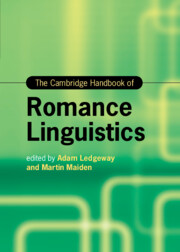Book contents
- The Cambridge Handbook of Romance Linguistics
- Cambridge Handbooks in Language and Linguistics
- The Cambridge Handbook of Romance Linguistics
- Copyright page
- Dedication
- Contents
- Figures
- Tables
- Contributors
- Abbreviations
- 1 Data, Theory, and Explanation: The View from Romance
- Part One What Is a Language?
- Part Two Phonetics and Phonology
- Part Three Morphology
- 10 Phonological and Morphological Conditioning
- 11 The Autonomy of Morphology
- 12 Suppletion
- 13 Inflexion, Derivation, Compounding
- 14 Evaluative Suffixes
- 15 Counting Systems
- Part Four Syntax
- Part Five Semantics and Pragmatics
- Part Six Language, Society, and the Individual
- Index
- References
11 - The Autonomy of Morphology
from Part Three - Morphology
Published online by Cambridge University Press: 23 June 2022
- The Cambridge Handbook of Romance Linguistics
- Cambridge Handbooks in Language and Linguistics
- The Cambridge Handbook of Romance Linguistics
- Copyright page
- Dedication
- Contents
- Figures
- Tables
- Contributors
- Abbreviations
- 1 Data, Theory, and Explanation: The View from Romance
- Part One What Is a Language?
- Part Two Phonetics and Phonology
- Part Three Morphology
- 10 Phonological and Morphological Conditioning
- 11 The Autonomy of Morphology
- 12 Suppletion
- 13 Inflexion, Derivation, Compounding
- 14 Evaluative Suffixes
- 15 Counting Systems
- Part Four Syntax
- Part Five Semantics and Pragmatics
- Part Six Language, Society, and the Individual
- Index
- References
Summary
In this contribution we acknowledge that morphology interacts with, and is intimately related to, semantics, syntax, and phonology, but we maintain that it has an existence independent to these systems and is not conceptually irreducible to them. This fact underlies the claim of the autonomy of morphology: that morphology possesses its own laws, principles, and methodology which are not simply deducible from or reducible to those of other disciplines. We provide a brief overview of the origins of the concept of autonomous morphology, the main ways that it has been applied to the Romance languages, and how it is related to the concept of the morphome. We then provide a typological overview of the canonical cases of linguistic structures which support the autonomy of morphology and note the magnitude of evidence from the Romance languages. We conclude with some theoretical observations and reflections as to why purely morphological phenomena have so often been reduced to syntactic or phonological explanations. We suggest that the answer lies in ingrained assumptions about the basic units of mental storage, morphology being conceived as a concatenative constructive process and a theoretical reductionist tendency to relate phenomena to a single coherent system and organizing principle.
- Type
- Chapter
- Information
- The Cambridge Handbook of Romance Linguistics , pp. 346 - 370Publisher: Cambridge University PressPrint publication year: 2022
References
Selected References
- 2
- Cited by

